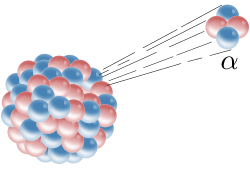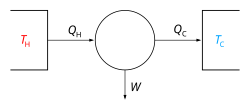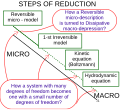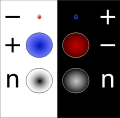thermodynamics, the particle number (symbol N) of a thermodynamic system is the number of constituent particles in that system. The particle number is a fundamental...
4 KB (446 words) - 21:10, 23 July 2024
In the physical sciences, a particle (or corpuscle in older texts) is a small localized object which can be described by several physical or chemical properties...
18 KB (1,643 words) - 15:49, 14 May 2025
where the total number of particles may not be preserved, the number operator is the observable that counts the number of particles. The following is...
3 KB (556 words) - 18:38, 16 April 2025
and particles with a reservoir, so that various possible states of the system can differ in both their total energy and total number of particles. The...
37 KB (5,285 words) - 16:37, 8 April 2025
A virtual particle is a theoretical transient particle that exhibits some of the characteristics of an ordinary particle, while having its existence limited...
23 KB (2,949 words) - 20:35, 23 May 2025
physics, a subatomic particle is a particle smaller than an atom. According to the Standard Model of particle physics, a subatomic particle can be either a...
36 KB (3,383 words) - 07:57, 24 June 2025
hypothesized microscopic particles in particle physics, condensed matter physics and cosmology. Elementary particles are particles with no measurable internal...
25 KB (2,542 words) - 18:53, 17 May 2025
In particle physics, an elementary particle or fundamental particle is a subatomic particle that is not composed of other particles. The Standard Model...
36 KB (3,556 words) - 16:30, 16 June 2025
Particle physics or high-energy physics is the study of fundamental particles and forces that constitute matter and radiation. The field also studies...
42 KB (4,294 words) - 17:15, 11 June 2025
Fock state (redirect from Number State)
mechanics, a Fock state or number state is a quantum state that is an element of a Fock space with a well-defined number of particles (or quanta). These states...
30 KB (5,643 words) - 09:06, 3 June 2025
Alpha particles, also called alpha rays or alpha radiation, consist of two protons and two neutrons bound together into a particle identical to a helium-4...
33 KB (4,208 words) - 06:51, 21 June 2025
temperature and entropy, pressure and volume, or chemical potential and particle number. In fact, all thermodynamic potentials are expressed in terms of conjugate...
12 KB (1,643 words) - 03:10, 13 February 2025
Chemical potential (category Wikipedia articles needing page number citations from April 2024)
the energy that can be absorbed or released due to a change of the particle number of the given species, e.g. in a chemical reaction or phase transition...
33 KB (4,561 words) - 03:57, 24 June 2025
Cross section (physics) (redirect from Particle cross section)
in a collision of two particles. For example, the Rutherford cross-section is a measure of probability that an alpha particle will be deflected by a...
36 KB (5,765 words) - 12:42, 17 June 2025
system is particle-transfer connected, by a particle-permeable boundary, to a constant-μ reservoir. The conjugate here is a constant particle number process...
16 KB (2,191 words) - 14:54, 18 December 2024
of separate particles. When an ensemble describes a system of particles with similar properties, their number is called the particle number and usually...
4 KB (488 words) - 20:59, 3 November 2024
the same total energy and particle number. The system must remain totally isolated (unable to exchange energy or particles with its environment) in order...
29 KB (4,028 words) - 18:24, 1 April 2025
Boltzmann equation (category Wikipedia articles needing page number citations from March 2025)
as energy, charge or particle number. The equation arises not by analyzing the individual positions and momenta of each particle in the fluid but rather...
36 KB (5,027 words) - 04:28, 7 April 2025
Wave–particle duality is the concept in quantum mechanics that fundamental entities of the universe, like photons and electrons, exhibit particle or wave...
28 KB (2,963 words) - 22:12, 22 May 2025
Antiparticle (redirect from Anti-particle)
In particle physics, every type of particle of "ordinary" matter (as opposed to antimatter) is associated with an antiparticle with the same mass but with...
24 KB (2,655 words) - 00:53, 16 May 2025
non-interacting identical particles may occupy a set of available discrete energy states at thermodynamic equilibrium. The aggregation of particles in the same state...
39 KB (6,051 words) - 17:49, 13 June 2025
A strange particle is an elementary particle with a strangeness quantum number different from zero. Strange particles are members of a large family of...
2 KB (244 words) - 17:03, 21 June 2025
The number density (symbol: n or ρN) is an intensive quantity used to describe the degree of concentration of countable objects (particles, molecules,...
7 KB (808 words) - 15:26, 26 May 2025
Particle number concentration, also particle number density, term used in thermodynamics related to Particle number Post-nut clarity PNC Center (disambiguation)...
2 KB (239 words) - 19:17, 15 June 2025
Schrödinger equation (section Particle in a box)
complex number to each point x {\displaystyle x} at each time t {\displaystyle t} . The parameter m {\displaystyle m} is the mass of the particle, and V...
75 KB (10,263 words) - 16:18, 24 June 2025
Particle agglomeration refers to the formation of assemblages in a suspension and represents a mechanism leading to the functional destabilization of colloidal...
21 KB (2,603 words) - 04:47, 12 April 2025
In particle physics, flavour or flavor refers to the species of an elementary particle. The Standard Model counts six flavours of quarks and six flavours...
24 KB (2,963 words) - 05:44, 5 June 2025
Boson (redirect from Bose particle)
In particle physics, a boson (/ˈboʊzɒn/ /ˈboʊsɒn/) is a subatomic particle whose spin quantum number has an integer value (0, 1, 2, ...). Bosons form...
10 KB (1,132 words) - 06:00, 8 June 2025
the derivative is taken at fixed entropy ( S {\displaystyle S} ) and particle number ( N {\displaystyle N} ). The SI unit for pressure is the pascal (Pa)...
46 KB (5,784 words) - 16:09, 21 May 2025
In particle physics, particle decay is the spontaneous process of one unstable subatomic particle transforming into multiple other particles. The particles...
10 KB (1,276 words) - 23:41, 8 June 2025











